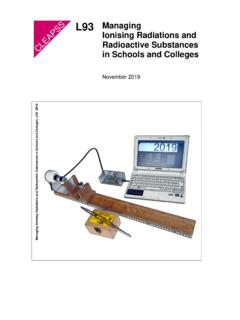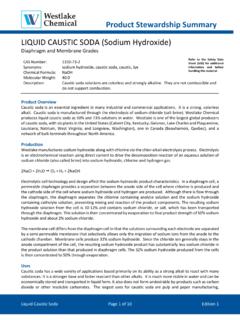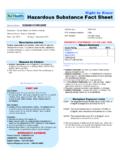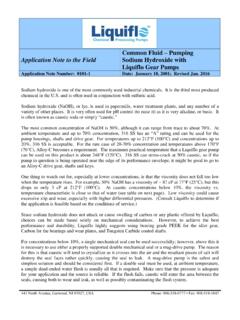Transcription of Student safety sheets 31 Sodium hydroxide
1 Student safety sheets 31. Sodium hydroxide also applies to Soda lime and Potassium hydroxide Substance Hazard Comment Sodium or potassium hydroxide DANGER: causes severe skin burns and eye damage. Solid Potassium hydroxide is also harmful if swallowed. Also known as caustic soda and caustic potash. CORROSIVE It gives out heat when added to water which can cause Soda lime contains about 5% Sodium hydroxide , boiling or create a choking mist. 1% potassium hydroxide , silicon dioxide, 14 It is used in the home for clearing drains. 19% water and the remainder calcium hydroxide (it HARMFUL. is used to absorb carbon dioxide). Carbosorb in addition contains an indicator.
2 Sodium or potassium hydroxide solution DANGER: causes severe skin burns and eye damage. ( Sodium hydroxide if M or more; Potassium hydroxide is also harmful if swallowed if 3 M. potassium hydroxide if M or more) CORROSIVE. or more. Fehling's solution contains Sodium hydroxide of this concentration. It is used in the home as an oven cleaner. HARMFUL. Dilute Sodium or potassium hydroxide WARNING: irritating to the eyes and skin. solution ( Sodium hydroxide If less than M but M or IRRITANT. more; potassium hydroxide if less than M but M or more). Very dilute Sodium or potassium hydroxide LOW HAZARD. It may still cause harm in the eyes or in a cut.
3 Solution ( Sodium hydroxide If less than M;. potassium hydroxide if less than M). Typical control measures to reduce risk Use the lowest concentration possible; avoid using the solid if possible. Use the smallest amount possible. Wear eye protection, including when making or disposing of solutions. Goggles (or a face shield) rather than safety spectacles will be necessary if the chemical is classed as CORROSIVE at the concentration used. Wear protective gloves if the concentrated solution is handled in more than tiny amounts. If possible, use a safer alternative, eg, Sodium carbonate when making salts or Benedict's solution rather than Fehling's solution for food tests.
4 Assessing the risks What are the details of the activity to be undertaken? What are the hazards? What is the chance of something going wrong? eg, solution spurting out of test tubes when being heated. How serious would it be if something did go wrong? NB Alkali in the eye causes more damage than acid of equivalent concentration. How can the risk(s) be controlled for this activity? eg, can it be done safely? Does the procedure need to be altered? Should goggles or safety spectacles be worn? Emergency action In the eye Flood the eye with gently-running tap water for at least 20 minutes. Consult a medic. If it is necessary to go to hospital, continue washing the eye during the journey in an ambulance.
5 Swallowed Do no more than wash out the mouth with drinking water. Do not induce Consult a medic. Spilt on the skin or Remove contaminated clothing. Then drench the skin with plenty of water. clothing If a large area is affected or blistering occurs, consult a medic . Spilt on the floor, Wipe up small amounts with a damp cloth and rinse it well. For larger amounts, and especially bench, etc for (moderately) concentrated solutions, cover with mineral absorbent (eg, cat litter) and scoop into a bucket. Neutralise with citric acid. Rinse with plenty of water. Student safety sheets are teaching materials. For safety management, use Hazcards and other resources on the CLEAPSS website.
6 CLEAPSS 2019.

















